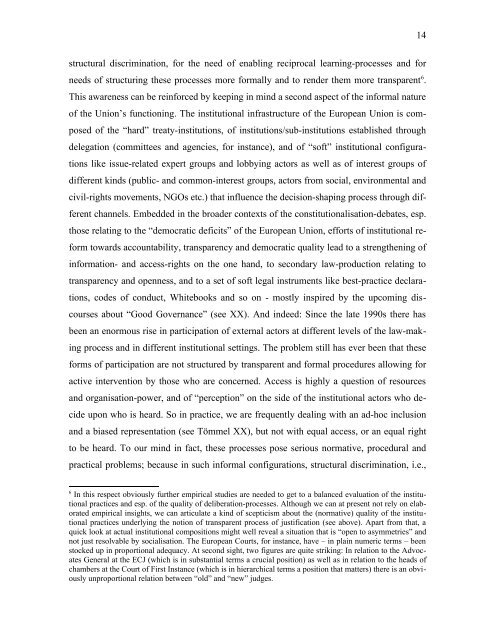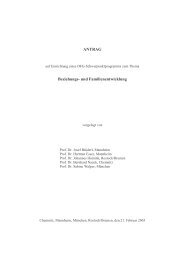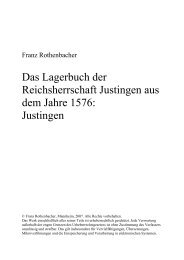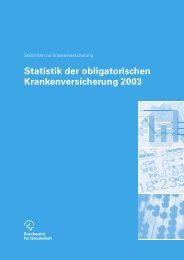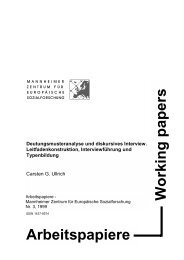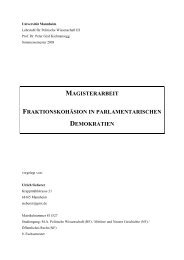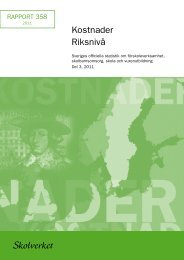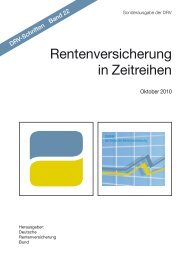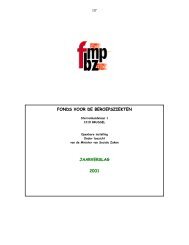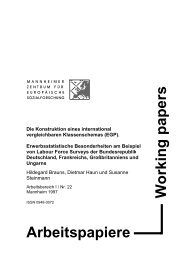Tobias Auberger and Tanja Hitzel-Cassagnes - Mzes
Tobias Auberger and Tanja Hitzel-Cassagnes - Mzes
Tobias Auberger and Tanja Hitzel-Cassagnes - Mzes
You also want an ePaper? Increase the reach of your titles
YUMPU automatically turns print PDFs into web optimized ePapers that Google loves.
14<br />
structural discrimination, for the need of enabling reciprocal learning-processes <strong>and</strong> for<br />
needs of structuring these processes more formally <strong>and</strong> to render them more transparent 6 .<br />
This awareness can be reinforced by keeping in mind a second aspect of the informal nature<br />
of the Union’s functioning. The institutional infrastructure of the European Union is composed<br />
of the “hard” treaty-institutions, of institutions/sub-institutions established through<br />
delegation (committees <strong>and</strong> agencies, for instance), <strong>and</strong> of “soft” institutional configurations<br />
like issue-related expert groups <strong>and</strong> lobbying actors as well as of interest groups of<br />
different kinds (public- <strong>and</strong> common-interest groups, actors from social, environmental <strong>and</strong><br />
civil-rights movements, NGOs etc.) that influence the decision-shaping process through different<br />
channels. Embedded in the broader contexts of the constitutionalisation-debates, esp.<br />
those relating to the “democratic deficits” of the European Union, efforts of institutional reform<br />
towards accountability, transparency <strong>and</strong> democratic quality lead to a strengthening of<br />
information- <strong>and</strong> access-rights on the one h<strong>and</strong>, to secondary law-production relating to<br />
transparency <strong>and</strong> openness, <strong>and</strong> to a set of soft legal instruments like best-practice declarations,<br />
codes of conduct, Whitebooks <strong>and</strong> so on - mostly inspired by the upcoming discourses<br />
about “Good Governance” (see XX). And indeed: Since the late 1990s there has<br />
been an enormous rise in participation of external actors at different levels of the law-making<br />
process <strong>and</strong> in different institutional settings. The problem still has ever been that these<br />
forms of participation are not structured by transparent <strong>and</strong> formal procedures allowing for<br />
active intervention by those who are concerned. Access is highly a question of resources<br />
<strong>and</strong> organisation-power, <strong>and</strong> of “perception” on the side of the institutional actors who decide<br />
upon who is heard. So in practice, we are frequently dealing with an ad-hoc inclusion<br />
<strong>and</strong> a biased representation (see Tömmel XX), but not with equal access, or an equal right<br />
to be heard. To our mind in fact, these processes pose serious normative, procedural <strong>and</strong><br />
practical problems; because in such informal configurations, structural discrimination, i.e.,<br />
6<br />
In this respect obviously further empirical studies are needed to get to a balanced evaluation of the institutional<br />
practices <strong>and</strong> esp. of the quality of deliberation-processes. Although we can at present not rely on elaborated<br />
empirical insights, we can articulate a kind of scepticism about the (normative) quality of the institutional<br />
practices underlying the notion of transparent process of justification (see above). Apart from that, a<br />
quick look at actual institutional compositions might well reveal a situation that is “open to asymmetries” <strong>and</strong><br />
not just resolvable by socialisation. The European Courts, for instance, have – in plain numeric terms – been<br />
stocked up in proportional adequacy. At second sight, two figures are quite striking: In relation to the Advocates<br />
General at the ECJ (which is in substantial terms a crucial position) as well as in relation to the heads of<br />
chambers at the Court of First Instance (which is in hierarchical terms a position that matters) there is an obviously<br />
unproportional relation between “old” <strong>and</strong> “new” judges.


